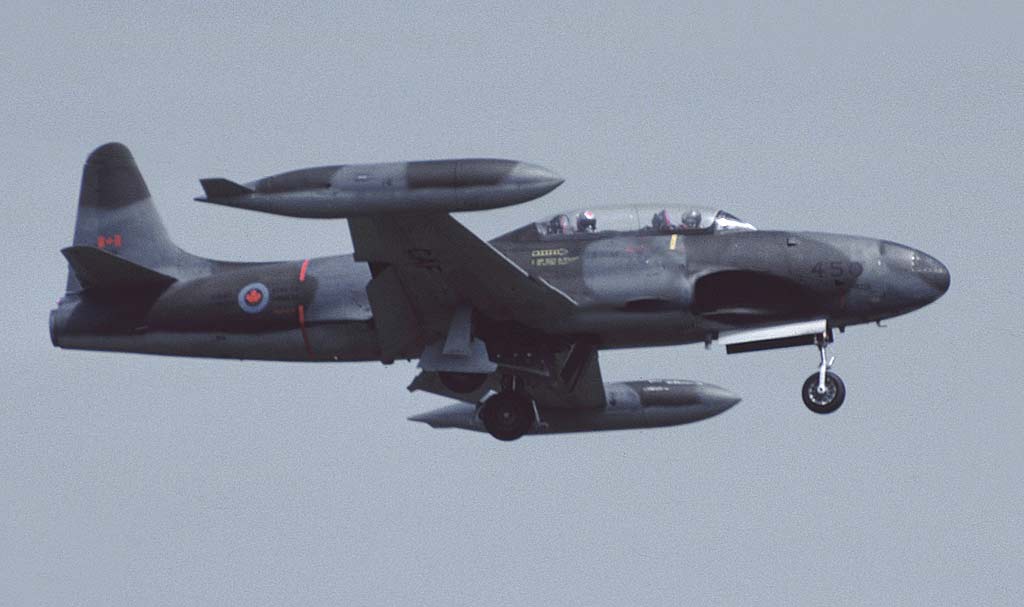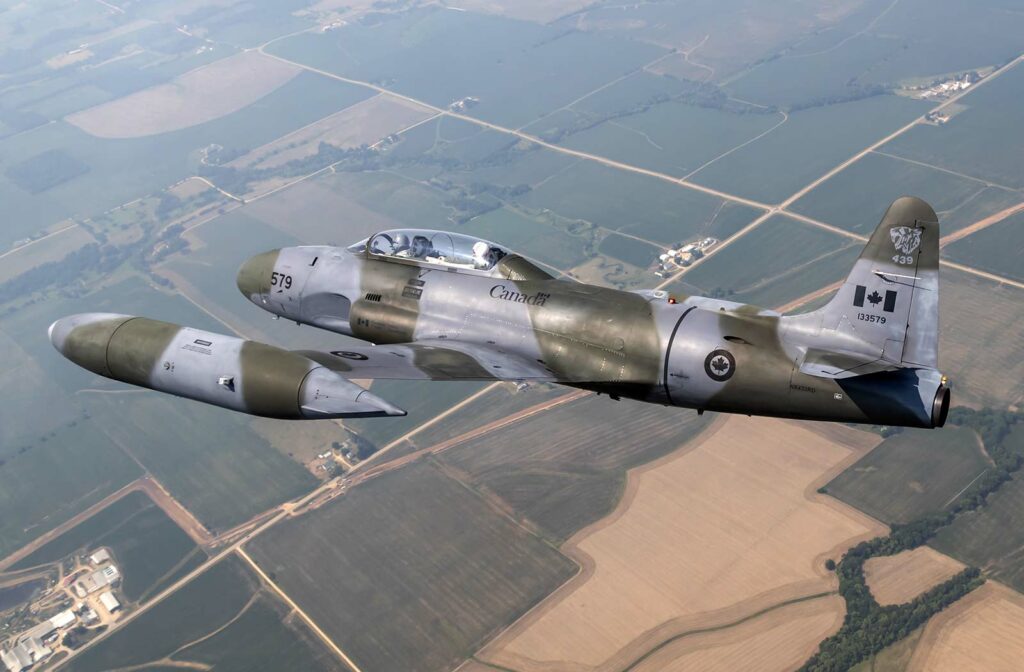The Canadair CT-133 Silver Star was a Canadian-built training and utility jet derived from the Lockheed T-33.
In brief
The Canadair CT-133 Silver Star, a variant of the Lockheed T-33 Shooting Star, was a jet trainer aircraft used extensively by the Royal Canadian Air Force (RCAF) and other nations. It was known for its reliability and adaptability, serving various roles from training pilots in jet operations to performing as an electronic warfare and target towing platform. Produced under license in Canada, the CT-133 featured an elongated fuselage, tip tanks, and a Rolls-Royce Nene turbojet engine, distinguishing it from its American counterpart. It remained in service for several decades, reflecting its enduring utility and robust design.
The Canadair CT-133 Silver Star played a significant role in the training and operational support of several air forces for over five decades. As a licensed production of the Lockheed T-33 Shooting Star, it was adapted to meet specific training and utility needs, particularly in Canada.

History of the Development of the Canadair CT-133 Silver Star
Post World War II aviation saw rapid advancements in jet technology, necessitating effective training platforms for pilots transitioning from propeller-driven to jet-powered aircraft. The Canadair CT-133 Silver Star was developed to address this need, especially within the Royal Canadian Air Force and allied nations. It was built under license in Canada by Canadair (now part of Bombardier Aerospace), who chose to modify the Lockheed T-33 Shooting Star with a more powerful engine and other improvements suitable for Canadian and international conditions.
The development program was launched in the late 1940s, with Canadair producing its first CT-133 in 1952. The aircraft was widely adopted due to the increasing need for jet training and the reliability demonstrated by its American predecessor, the T-33. The CT-133 did not receive a specific NATO nickname but was commonly referred to as the “T-Bird” in various air forces, aligning with the T-33’s nickname.
Design of the Canadair CT-133 Silver Star
The Canadair CT-133 Silver Star’s design closely mirrored that of the Lockheed T-33 but included several modifications. Most notably, it was powered by a Rolls-Royce Nene 10 turbojet engine, replacing the Allison J33 used in the American version. This change provided better performance in terms of thrust and altitude capabilities. The aircraft had an overall length of approximately 37 ft (11.27 m) and a wingspan of 38 ft (11.58 m).
The CT-133 maintained the T-33’s characteristic straight wing and tail design, as well as the tip tanks for extended range. It featured a two-seat cockpit, with student and instructor sitting in tandem. The design emphasized ease of maintenance, reliability, and adaptability, allowing it to serve in various roles beyond pilot training, including electronic warfare, target towing, and reconnaissance.
Performance of the Canadair CT-133 Silver Star
The Canadair CT-133 Silver Star’s performance was characterized by its reliability and effectiveness as a trainer. Powered by the Rolls-Royce Nene turbojet, it had a maximum speed of around 600 mph (965 km/h) and a service ceiling of 45,000 ft (13,716 m). Its range was approximately 1,275 miles (2,050 km) with tip tanks.
In comparison to other training aircraft of the era, the CT-133 was particularly valued for its jet-like handling characteristics, providing a realistic training environment for pilots transitioning to operational jet aircraft. It wasn’t necessarily the most powerful or fastest trainer available, but its balance of performance, reliability, and versatility made it a staple in many air forces’ training fleets.
Variants of the Canadair CT-133 Silver Star
The Canadair CT-133 Silver Star saw various variants throughout its service life. The most common variant was the CT-133AN Silver Star 3, which was the standard model used by the RCAF and other nations. There were also specialized versions adapted for electronic warfare, reconnaissance, and target towing missions, among others. Each variant maintained the core design elements of the CT-133 but was modified with different equipment and capabilities to suit specific roles.

Military use and combat of the Canadair CT-133 Silver Star
The primary role of the Canadair CT-133 Silver Star was as a training aircraft, preparing pilots for the transition to faster and more complex jet fighters and bombers. However, it also served in various utility and support roles. It was used for electronic warfare training, target towing, and even as a light reconnaissance platform in some cases. The CT-133 was widely used by the RCAF and was also exported to several countries, including NATO and Commonwealth allies.
While it was not designed as a front-line combat aircraft, its versatility meant it was often used in secondary roles during conflicts. Its reliability and ease of maintenance made it a valuable asset for air forces worldwide. The aircraft was eventually phased out from primary training roles as more advanced, jet-specific trainers became available, but it continued to serve in secondary capacities for many years.
The Canadair CT-133 Silver Star was an indispensable part of jet pilot training and served various air forces with distinction for over five decades. Its design as a reliable, adaptable, and effective trainer allowed countless pilots to safely transition to the jet age. While primarily a trainer, its versatility in various support roles further exemplifies its significant contribution to military aviation. The legacy of the CT-133 Silver Star endures not only in the pilots it trained but also in the development and progression of jet training methodologies and technologies.
Back to the Fighter Jet section.